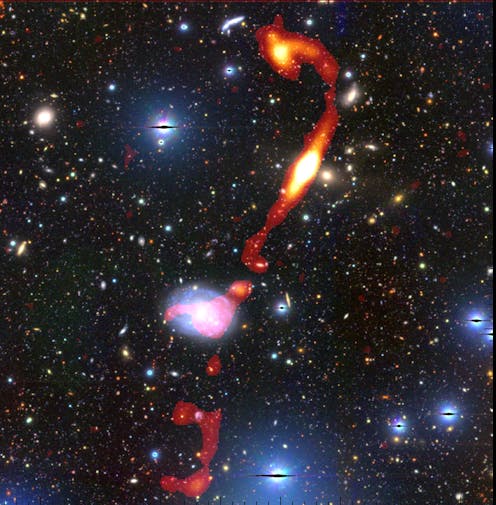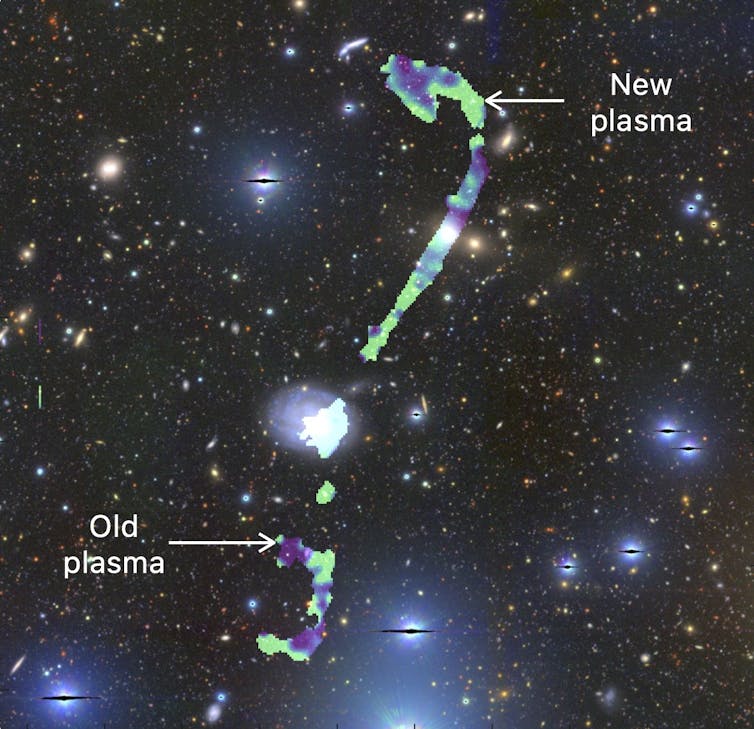
You may not know it, but right now there’s a huge cosmic rave party happening far, far above our heads. The chief party goers are known as supermassive black holes. These mysterious objects can have masses several million or billion times that of the Sun and are so dense that they warp space time around them.
As far as astronomers know, all galaxies harbour a supermassive black hole at their very centres. In some galaxies, large amounts of interstellar gas are spiralling around the supermassive black hole and getting pulled in beyond the event horizon and essentially on to the black hole. This process creates a huge amount of friction and energy, which can cause the “rave” I’m talking about – releasing huge amounts of light at many different colours and frequencies across the electromagnetic spectrum.
In some cases, the black hole will even spew jets of plasma, millions of light-years across intergalactic space. The plasma gas is so hot that it’s essentially a soup of electrons moving close to the speed of light. These plasma jets glow at radio frequencies, so they can be seen with a radio telescope and are, aptly, named radio galaxies. In a recent episode of the astronomy podcast The Cosmic Savannah, I likened their appearance to two glow sticks (the plasma jets) poking out of a ball of sticky tack (the galaxy). Astronomers hypothesise that the plasma jets keep expanding outwards as time passes, eventually growing so large that they become giant radio galaxies.
Millions of normally sized radio galaxies are known to science. But by 2020 only about 800 giant radio galaxies had been found, nearly 50 years since they had been initially discovered. They were considered rare. However, a new generation of radio telescopes, including South Africa’s MeerKAT, have turned this idea on its head: in the past five years about 11,000 giants have been discovered.
MeerKAT’s newest giant radio galaxy find is extraordinary. The plasma jets of this cosmic giant span 3.3 million light-years from end to end – over 32 times the size of the Milky Way. I’m one of the lead researchers who made the discovery. We’ve nicknamed it Inkathazo, meaning “trouble” in South Africa’s isiXhosa and isiZulu languages. That’s because it’s been a bit troublesome to understand the physics behind what’s going on with Inkathazo.
This discovery has given us a unique opportunity to study giant radio galaxies. The findings challenge existing models and suggest that we don’t yet understand much of the complicated plasma physics at play in these extreme galaxies.
Here comes ‘trouble’
The MeerKAT telescope is located in the Karoo region of South Africa, is made up of 64 radio dishes and is operated and managed by the South African Radio Astronomy Observatory. It’s a precursor to the Square Kilometre Array, which will, when it commences science operations around 2028, be the world’s largest telescope.
MeerKAT has already been pivotal in uncovering some of the hidden treasures of the southern sky since it was first commissioned in 2018.
This is the third giant radio galaxy that my collaborators and I have discovered with MeerKAT in a relatively small patch of sky near the equator, around the size of five full moons, that astronomers refer to as the “COSMOS field”. We pointed MeerKAT at COSMOS during the early stages of the most advanced surveys of distant galaxies ever conducted: the International Gigahertz Tiered Extragalactic Exploration (MIGHTEE).
Read more: Discovery of two new giant radio galaxies offers fresh insights into the universe
The MIGHTEE team, a collaboration of astronomers from around the world, and I first published the discovery of the two other giant radio galaxies in COSMOS in 2021.
We spotted Inkathazo more recently in my own MeerKAT follow-up observations of COSMOS, as well as in the full MIGHTEE survey.
However, Inkathazo differs from its cosmic companions in several ways. It doesn’t have the same characteristics as many other giant radio galaxies. For example, the plasma jets have an unusual shape. Rather than extending straight across from end-to-end, one of the jets is bent.
Additionally, Inkathazo lives at the very centre of a cluster of galaxies, rather than in relative isolation, which should make it difficult for the plasma jets to grow to such enormous sizes. Its location in a cluster raises questions about the role of environmental interactions in the formation and evolution of these giant galaxies.

MeerKAT’s exceptional capabilities are helping us to unravel this cosmic conundrum. We’ve created some of the highest-resolution spectral maps ever made for giant radio galaxies. These maps track the age of the plasma across different parts of the galaxy, providing clues about the physical processes at work.
The results revealed intriguing complexities in Inkathazo’s jets. Some electrons within the plasma jets receive unexpected boosts of energy. We think this may occur when the jets collide with hot gas in the voids between galaxies in a cluster. This gives us hints about what sort of plasma physics might be happening in these extreme parts of the Universe that we didn’t previously predict.
A treasure trove
The fact that we unveiled three giant radio galaxies by pointing MeerKAT at a single patch of sky suggests that there’s likely a huge treasure trove of these cosmic behemoths just waiting to be discovered in the southern sky. The telescope is incredibly powerful and it’s in a perfect location for this kind of research, so it’s ideally poised to uncover and learn more about giant radio galaxies in the years to come.
Kathleen Charlton, a Master’s student at the University of Cape Town, was the lead author of the research on which this article was based.
Jacinta Delhaize receives funding from the Africa-Oxford Initiative and the National Research Foundation.
This article was originally published on The Conversation. Read the original article.







